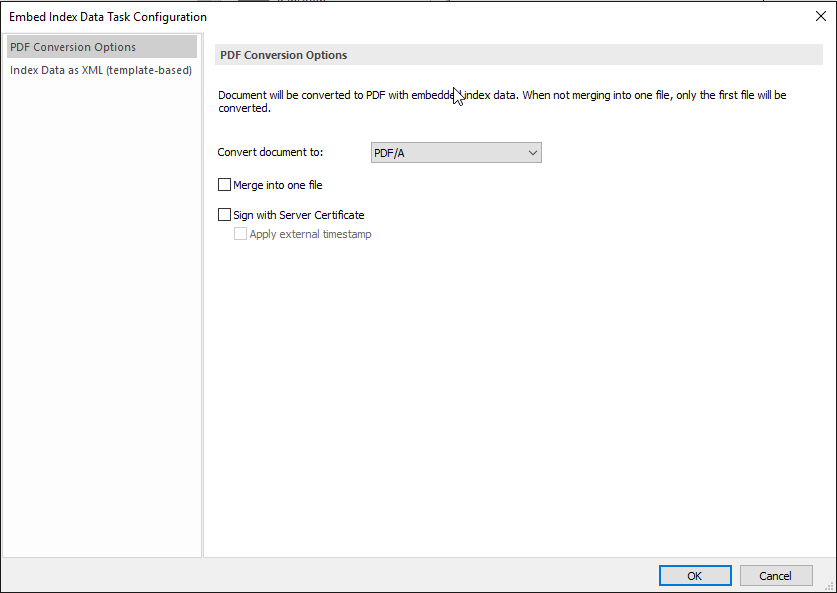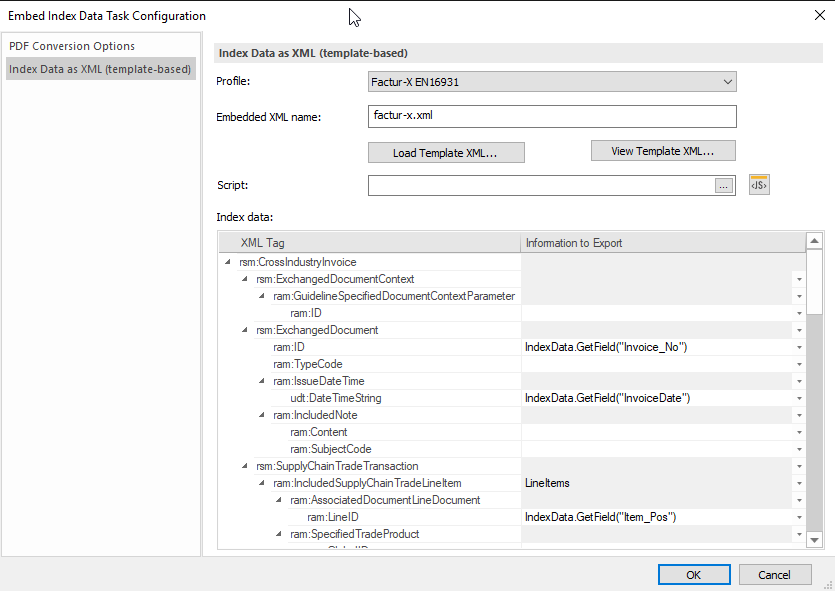
|
Embed Index Data |
Scroll |
|
The Therefore™ document will be converted to either PDF or PDF/A-3 format and the index data will be embedded within it as an XML file attachment. This PDF will be stored as a new document version. The embedded XML will be configured in the same way as the exported index data XML file of the 'Export Document' workflow task in “XML (template-based)” mode. |

Convert document to:
The document file can be converted to either PDF or PDF/A-3b file formats.
Merge into one file
Click the checkbox to merge all the files in the workflow document into one single PDF file.
Otherwise, only the first file of the workflow document will be converted to PDF.
Â
Sign the Server Certificate
Selecting this option, the PDF file will be signed with the certificate configured in the “Server Certificate Name” Therefore setting.
Â
Apply external timestamp
An external trusted timestamp server will be used when signing the PDF document. This timestamp server must be defined in the Therefore™ Solution Designer's advanced settings (under General/Timestamp Server).

Profile:
This setting modifies the internal content of the generated PDF; it adds Factur-X or Zugferd specific “PDF metadata” (XMP) to the PDF file, as specified by the Factur-X or Zugferd standard.
|
Possible values for 'Profile':
•"Custom" (means: not adding PDF metadata to the PDF file), •"Factur-X BASIC", •"Factur-X EN16931", •"Factur-X EXTENDED", •"ZUGFeRD 2.0 BASIC", •"ZUGFeRD 2.0 EN16931", •"ZUGFeRD 2.0 EXTENDED", •"ZUGFeRD 2.1 BASIC", •"ZUGFeRD 2.1 EN16931", •"ZUGFeRD 2.1 EXTENDED" |
Embedded XML name:
Specify the name for the XML file which will contain the index data. This name will be used within the PDF to denote the embedded XML file.
Load Template XML...
Load the XML-template into the Index Data assignment table.
View Template XML...
View and modify the XML-template in the Notepad application.
Script
A initialization script can be created, which will be executed before the execution of the field assignments. Also, variables and functions could be defined here that will be available for the assignment scripts.
Index Data:
Specify how the XML template will be filled with index data, that is, how the actual export-XML will be generated from the template. Scripts returning a certain value (typically: an index field value) can be created here and assigned to the “leaf” tags of the XML template. During export, these “leaf” tags will be filled with the assigned script result values.
|
When an assignment script returns an array of values, e.g. when the script returns table index field column values, then the assigned “leaf” tag will be repeated in the resulting XML, as many times as the element count in the array.
It is possible to enlarge the repetitive XML part from “leaf” tag to a whole sub-tag structure by assigning accordingly from a table field ID to a non-leaf tag.
Example: when using Facture-X or Zugferd XML-template, then the field-ID of the table index field containing the invoice line items has to be assigned to the <ram:IncludedSupplyChainTradeLineItem> XML-tag. Thus, the <ram:IncludedSupplyChainTradeLineItem> XML-tag and the belonging sub-structure will be the repetitive XML part, as expected according to the Facture-X/Zugferd standard.
Note: in this case, the <ram:LineID> tags will be filled automatically with increasing numbers beginning from 1, when no assignment configured for this XML-tag. |


